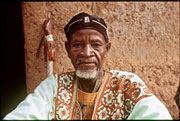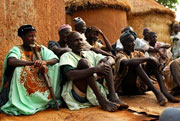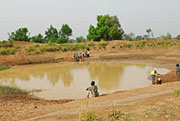The muddy pond is as brown as the hillsides surrounding it. It is the peak of dry season in Ghana and Chief Tahanaa looks over the water he has been drinking since he was a child.
"I know what people are going through," he says, lifting his robe to reveal a sunken, coin-size scar on his left calf.
His scar is a reminder of the Guinea worm disease he suffered as a child. Today, painful memories drive his commitment to eradicate the ancient disease from his village. Chief Tahanaa's dedication is changing the face of his community and helping Guinea worm disease become the second disease in history to be eradicated after smallpox. The Carter Center continues to fight the last fraction of 1 percent of the disease in the nine African countries where it remains.
People contract Guinea worm disease when they consume stagnant water that is contaminated with tiny water fleas carrying infective larvae. Inside a human's abdomen, Guinea worm larvae grow for nearly a year. Once mature, the meter-long Guinea worm slowly emerges through a large, seeping blister in the skin. The crippling pain leaves victims unable to work or attend school, sometimes for months, until the worm is completely removed by a health care worker.
Peak transmission of Guinea worm disease coincides with the onset of the dry season, when communities are forced to share one water source. During this time, increased vigilance is necessary to prevent infected people from contaminating the water. Currently five communities collect water from Taha's pond.
To escape the intense burning sensation caused by the blister, sufferers often seek to cool their wounds in nearby water sources. When the worm touches water, it releases hundreds of thousands of larvae. Water fleas eat the larvae, and the disease cycle continues.
After a visit from Ghana's national Guinea worm program staff a few years ago, Chief Tahanaa realized there was something he could do to protect his village. He gathered the community for health education to ensure that everyone – old and young – learned how to prevent the debilitating disease. He had a platform built next to the pond so that water collectors would not step into it and possibly contaminate the water with Guinea worm larvae.
Chief Tahanaa levies fines, such as goats, on villagers who do not use the platform. Villagers who do not report cases to the local health volunteer or refuse treatment also are subject to similar fines.
When the Carter Center's Guinea Worm Eradication Program began in 1986 there were approximately 3.5 million cases in the world. Today there are approximately 10,700 cases-all in Africa. Thanks to numerous strong partnerships, the disease is steadily dwindling. Currently, Ghana is the most endemic country in West Africa, and second in the world only to war-torn Sudan. Together, Sudan and Ghana shoulder nearly 90 percent of the remaining Guinea worm cases.
In Ghana, for thousands of years the peak transmission of Guinea worm disease has coincided with the onset of the dry season. As small village ponds dry up, women and children are forced to walk farther and farther to collect water. Currently five other communities share Taha's water because their own water sources dried up weeks ago, increasing the chances that the disease might be introduced by someone from a Guinea worm-endemic community. One untreated Guinea worm case can cause a regional outbreak.
Several years ago a large Guinea worm outbreak in Taha left families unable to tend to their farms. The poor crop yield that season burdened the entire village. Today, the constant grinding of the peanut mill alludes to the community's good physical health and economic abundance.
"Now everyone is healthy and going about his or her activities," Chief Tahanaa says proudly.

(Photo: Rhett Turner)
Chief Tahanaa suffered from Guinea worm disease as a child. Knowing the crippling effects first hand, he vows to wipe out the disease from his village.

(Photo: The Carter Center)
Chief Tahanaa (left), sitting with Taha village councilmen, is fighting Guinea worm disease by imposing fines on people in the community who do not report cases of the disease. Once one of the most endemic villages in the Northern Region of Ghana, Tahanaa's efforts have nearly eliminated the disease from the village.

(Photo: The Carter Center)
People contract Guinea worm disease when they consume stagnant water contaminated with tiny water fleas carrying infective larvae.
Health Program Publications>
Guinea Worm Disease Links
Learn about the Center's Guinea Worm Eradication Program >
Read a Q&A with Carter Center experts on the historic Guinea Worm Eradication Campaign >
Total reported Guinea worm cases for 2005 >
Read more about the Carter Center's disease eradication and control efforts in The New York Times' "On The Brink" series >
Please sign up below for important news about the work of The Carter Center and special event invitations.